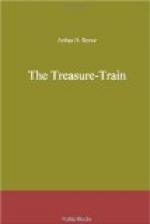“We are two to one,” returned Kennedy, nonchalantly. “That was nothing but the lock on the door closing. Mr. Jameson has a revolver in the top drawer of his desk over there. You will pardon me if I do a little telephoning—through the central office of the detective bureau? Some of our friends may not be overanxious to come here, and it may be necessary to compel their attendance.”
Sandoval subsided into a sullen silence as Kennedy made arrangements to have Burton Page, Anitra, Eulalie, and Teresa de Leon hurried to us at once.
There was nothing for me to do but watch Sandoval as Kennedy prepared a little instrument with a scale and dial upon which rested an indicator resembling a watch hand, something like the new horizontal clocks which have only one hand to register seconds, minutes, and hours. In them, like a thermometer held sidewise, the hand moves along from zero to twenty-four. In this instrument a little needle did the same thing. Pairs of little wire-like strings ran to the instrument.
Kennedy had finished adjusting another instrument which was much like the saccharimeter, only more complicated, when the racing of an engine outside announced the arrival of the party in one of the police department cars.
Between us, Craig and I lost no time in disposing the visitors so that each was in possession of a pair of the wire-like strings, and then disdaining to explain why he had gathered them together so unceremoniously, Kennedy turned and finished adjusting the other apparatus.
“Most people regard light, so abundant, so necessary, so free as a matter of course,” he remarked, contemplatively. “Not one person in ten thousand ever thinks of its mysterious nature or ever attempts to investigate it. In fact, most of us are in utter darkness as to light.”
He paused, tapped the machine and went on, “This is a polarimeter —a simple polariscope—a step beyond the saccharimeter,” he explained, with a nod at Sandoval. “It detects differences of structure in substances not visible in ordinary light.
“Light is polarized in several ways—by reflection, by transmission, but most commonly through what I have here, a prism of calcite, or Iceland spar, commonly called a Nicol prism. Light fully polarized consists of vibrations transverse to the direction of the ray, all in one plane. Ordinary light has transverse vibrations in all planes. Certain substances, due to their molecular structure, are transparent to vibrations in one plane, but opaque to those at right angles.
“Here we have,” he explained, tapping the parts in order, “a source of light, passing in through this aperture, here a Nicol polarizer, next a liquid to be examined in a glass-capped tube; here on this other side an arrangement of quartz plates with rotary power which I will explain in a moment, next an analyzer, and finally the aperture for the eye of an observer.”
Kennedy adjusted the glass tube containing the liquid which bore the substance scraped from the cartridge—he had picked up in the office of Jose. “Look through the eyepiece, Walter,” he directed.




